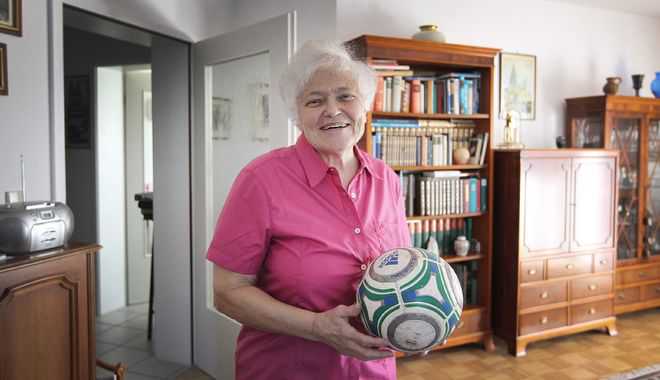Marseille, March 19
Women’s football has fought a long battle for recognition — but after several false starts the women’s game has grown and grown in popularity and this year’s World Cup in France promises to be the most-watched in history. The women’s game first emerged in Britain after World War I and found a new wave of support again in the late 1960s, before receding only to emerge again in the 1990s.
The emancipation movement after World War I triggered what many historians consider to be the golden age of women’s football.
As men were drafted to the front, women took their place on the factory floor, and in their breaks, some of them enjoyed a kick around in the yards, a tradition the male factory workers had previously enjoyed.
The era had its great team, the “Munitionnettes”, from Dick Kerr’s munitions factory in Preston, northwest England, and their star player, Lily Parr, remains the sole woman in English football’s Hall of Fame. She was inaugurated in 2009. On December 26, 1920, over 53,000 fans filled Everton’s Goodison Park to watch Dick Kerr’s Ladies beat St Helen’s 4-0.
But the following year, the Football Association banned women from playing on Football League grounds, saying “the game of football is quite unsuitable for females and ought not to be encouraged”.
Feminist movement
Women’s football then began to gain ground in Belgium, France and Germany. But without national infrastructures, it faded in the 1930s.
It was not until the 1960s that it was given fresh impetus by the burgeoning feminist movement. “The moment for the liberation of women liberated women not only politically but also physically,” historian Anais Bohuon, of Paris Sud university, said. “We could do what the men did and if we wanted to pursue physical pastimes, we could.”
The women’s game once again raised its head when the first European championships took place in 1969. It was won by Italy, although neither UEFA not FIFA recognised the event as official. A seven-nation World Cup was organised in Italy in 1970, won by Denmark, and several other events took place without FIFA’s approval.
‘A man’s world’
The women’s game advanced only slowly however, while feminism in the wider sense continued to gain only incremental progress in terms of gaining equal civil rights. Women playing football “was a concrete example of all the moral fears that have crossed the centuries surrounding women and their bodies and what they do with them,” Bohuon said.
The big exception was in the USA, where from the outset “soccer was seen as a women’s game, with girls playing from a very young age, and it became accepted behaviour,” Bohuon added.
It was no surprise then that it was American teams that dominated the first FIFA-backed World Cups, winning in 1991 and 1999, when 90,185 spectators watched the final at the Rose Bowl in California, which remains a world record for a women’s match.
UEFA organised its first official women’s European championships in 1984, won by Sweden, while the Asian federation had done the same as early as 1975.
Africa and South America created their regional competitions in 1991. — AFP
When Germany banned women’s football
Berlin: At 75, former footballer Baerbel Wohlleben (in pic) still clearly remembers the moment in 1974 when a journalist asked, “but when you head the ball, doesn’t it mess up your hair?” At that time, Wohlleben had already turned 30, but was only officially three years into her career as a footballer, because until 1971 the German football association (DFB) banned women from playing in competitions. Moreover, any clubs allowing women to train or play at their facilities was liable to be sanctioned. “...this aggressive sport is essentially alien to the nature of woman,” decreed the DFB in 1955. “In the fight for the ball, the feminine grace vanishes, body and soul will inevitably suffer harm.” Back then, even the idea of women wearing shorts was clearly a problem for the DFB as “the display of the body offends decency and modesty”. Nevertheless, the sexist rules from a bygone era did not stop Wohlleben playing football and she will be cheering the German team at the World Cup in France this June. At the age of 10, she kicked a ball for the first time on July 5, 1954 — the day West Germany won the World Cup for the first time by beating hot-favourites Hungary 3-2 in the final in Bern, Switzerland. “We were invited to a neighbour’s house and it was the first time I had seen a television,” remembered Wohlleben. “After the victory, we celebrated like crazy, went down to the garden and that’s where I said ‘I want to play football’.” For the next four years, she trained alongside boys at the same club as her three brothers, even playing some games at under-15 level. However, with women’s football then frowned upon in German society, Wohlleben drifted away. She played handball until, aged 27, a group of girls assembled a team in Woerrstadt, near her village of Ingelheim, where Wohlleben still lives. AFP
Unlock Exclusive Insights with The Tribune Premium
Take your experience further with Premium access.
Thought-provoking Opinions, Expert Analysis, In-depth Insights and other Member Only Benefits
Already a Member? Sign In Now










